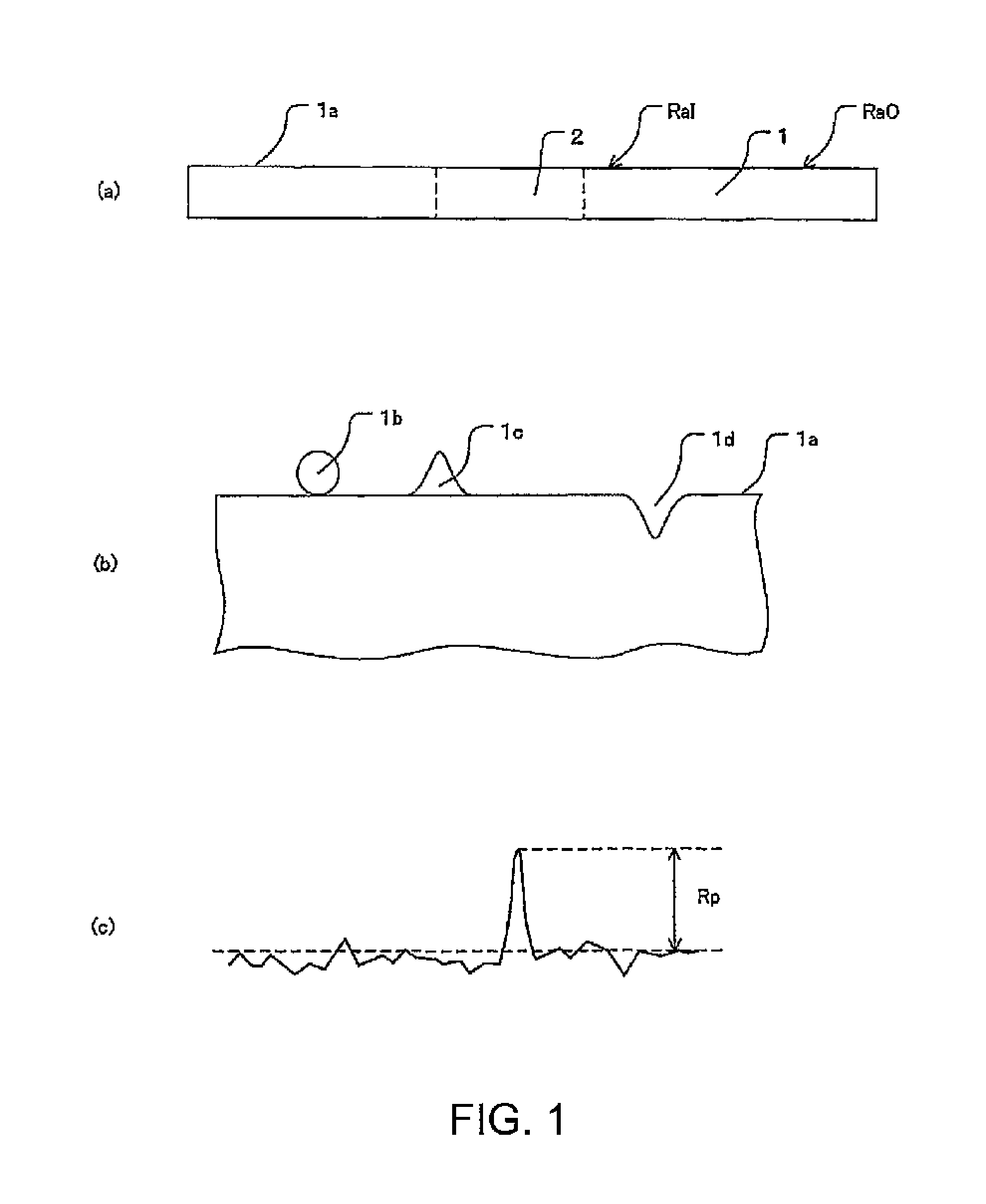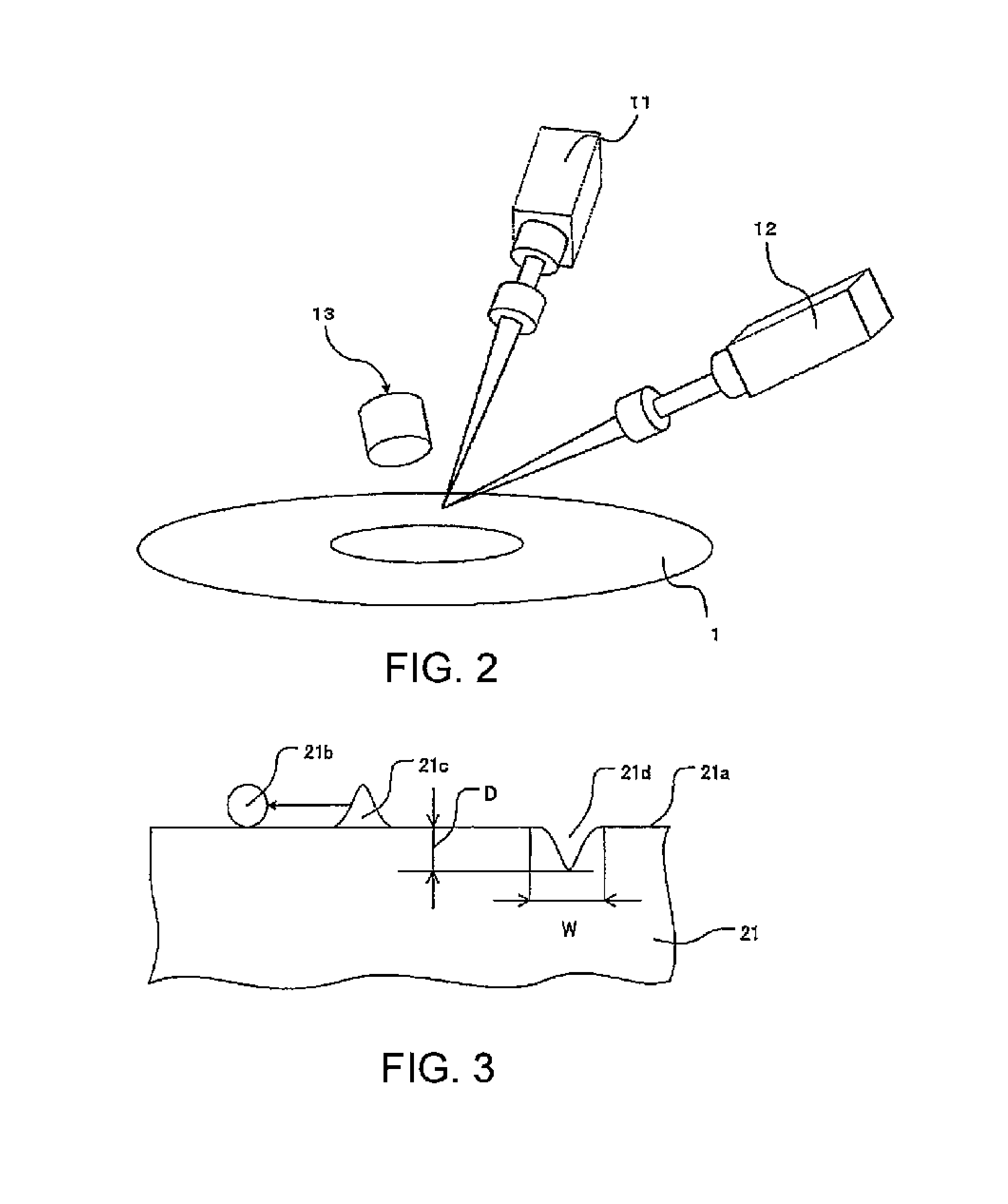Glass substrate for a magnetic disk and magnetic disk
a technology of magnetic disk and glass substrate, which is applied in the field of glass substrate for a magnetic disk and a magnetic disk, can solve the problems of stamper damage, etc., and achieve the effects of easy removal of foreign matter, high recording density, and increased chemical affinity
- Summary
- Abstract
- Description
- Claims
- Application Information
AI Technical Summary
Benefits of technology
Problems solved by technology
Method used
Image
Examples
embodiment 1
[0035]FIG. 1 shows diagrams of a magnetic disk glass substrate according to an embodiment 1, wherein (a) is a side view, (b) is a diagram for explaining defects present on a surface thereof, and (c) is a diagram for explaining the roughness of the surface.
[0036]A magnetic disk glass substrate 1 shown in FIG. 1 is such that an arithmetic mean roughness (Ra) of a main surface of the glass substrate measured using an atomic force microscope with a resolution of 256×256 pixels in a 2 μm×2 μm square is 0.12 nm or less and, among defects detected to have a size of 0.1 μm or more and 0.3 μm or less upon irradiating light with a wavelength of 405 nm onto the glass substrate with a spot size of 5 μm and detecting scattered light from the glass substrate, the number of the defects fixed to the glass substrate is 1 or less per 24 cm2.
[0037]As shown in FIG. 1(b), defects present on a surface 1a of the magnetic disk glass substrate 1 include adhering matter 1b of the kind that can be easily remo...
embodiment 2
[0057]FIG. 3 is a diagram for explaining defects present on a surface of a magnetic disk glass substrate according to an embodiment 2.
[0058]A magnetic disk glass substrate 21 shown in FIG. 3 is such that an arithmetic mean roughness (Ra) of a main surface of the glass substrate measured using an atomic force microscope with a resolution of 256×256 pixels in a 2 μm×2 μm square is 0.12 nm or less and the number of defects detected to have a size of 0.1 μm or more and 0.6 μm or less in plan view and a depth of 0.5 nm or more and 2 nm or less is less than 10 per 24 cm2, the defects each being detected using a shift in wavelength between incident light and reflected light upon irradiating and scanning helium neon laser light with a wavelength of 632 nm on the main surface of the glass substrate.
[0059]As shown in FIG. 3, defects present on a surface 21a of the magnetic disk glass substrate 21 include adhering matter 21b of the kind that can be easily removed by cleaning, and a convex defe...
embodiment 3
[0070]In this embodiment, a magnetic disk glass substrate manufacturing method will be described.
[0071]The magnetic disk glass substrate manufacturing method according to this embodiment comprises a process of applying at least shaping and lapping to a glass substrate having a pair of main surfaces, a polishing process of polishing the main surfaces, and a cleaning process of cleaning the glass substrate after the polishing, wherein an additive contained in a polishing liquid for use in the polishing process is contained in a cleaning liquid for use in the cleaning process.
[0072]More specifically, the manufacture of a magnetic disk glass substrate comprises (1) Shaping Process and First Lapping Process, (2) End Portion Shaping Process (coring process for forming a hole and chamfering process for forming chamfered faces at end portions (outer peripheral end portion and inner peripheral end portion) (chamfered face forming process)), (3) End Face Polishing Process (outer peripheral en...
PUM
| Property | Measurement | Unit |
|---|---|---|
| size | aaaaa | aaaaa |
| size | aaaaa | aaaaa |
| size | aaaaa | aaaaa |
Abstract
Description
Claims
Application Information
 Login to View More
Login to View More - R&D
- Intellectual Property
- Life Sciences
- Materials
- Tech Scout
- Unparalleled Data Quality
- Higher Quality Content
- 60% Fewer Hallucinations
Browse by: Latest US Patents, China's latest patents, Technical Efficacy Thesaurus, Application Domain, Technology Topic, Popular Technical Reports.
© 2025 PatSnap. All rights reserved.Legal|Privacy policy|Modern Slavery Act Transparency Statement|Sitemap|About US| Contact US: help@patsnap.com



